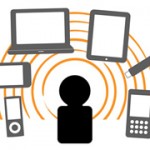 Mobile learning has been defined as: any sort of learning that happens when the learner is not at a fixed, predetermined location, or learning that happens when the learner takes advantage of the learning opportunities offered by mobile technologies.(Wikipedia) In other words mobile learning decreases limitation of learning location with the mobility of general portable devices.
Mobile learning has been defined as: any sort of learning that happens when the learner is not at a fixed, predetermined location, or learning that happens when the learner takes advantage of the learning opportunities offered by mobile technologies.(Wikipedia) In other words mobile learning decreases limitation of learning location with the mobility of general portable devices.
But mobile learning is more than just using mobile devices to learn – it is also about the mobility of the learner. According to Mike Sharples, a leading authority in the field, mobile learning can be defined as, “the processes (both personal and public) of coming to know through exploration and conversation across multiple contexts amongst people and interactive technologies.” (Sharples, M., et al, 2007) Kukulska-Hulme takes this further: Early definitions of [mobile learning], which focused predominantly on the attributes of mobile technology, have given way to more sophisticated conceptualisations suggesting that mobility is the central issue (Winters, 2006). This denotes not just physical mobility but the opportunity to overcome physical constraints by having access to people and digital learning resources, regardless of place and time.
Schools seem to be one step ahead – classroom uses for tablets and cell phones are vast and varied: kindergarteners learn to read using iPad apps; tablets have been deployed in schools and teachers are using them to monitor student progress; students are using smartphones (which often have stronger processing power than their schools’ desktop computers) for fact-finding, calculating and note-taking; teachers use cell phones to take instant polls in class to gauge comprehension; and schools are replacing print books for apps that feature videos and interactive quizzes.
Harvard professor Chris Dede who teaches at the Harvard Graduate School of Education is amazed at how quickly mobile devices are penetrating in schools. “I’ve never seen technology moving faster than mobile learning.” Dede also adds, “What I’m hearing from schools more is that they’ve eliminated policies restricting using mobile devices for learning and they’re interested in developing mobile learning programs as fast as possible. We’re going from districts fearing it and blocking it off to welcoming it and making it a major part of their technology plan. We’ll be surprised if a significant portion of districts aren’t using mobile learning inside and outside of schools soon.”
However with the latest technologies must come a “mind shift” – old delivery tactics will not work and teachers will then question the gains. Elliott Soloway, a professor at the University of Michigan School of Education and longtime proponent of mobile learning says that schools need to think about what they’ve gained in terms of student achievement through the use of mobile devices. “We are using new technology to implement old pedagogy,” he said. “We are not exploiting the affordances of the new technology to give kids new kinds of learn-by-doing activities. Flash card programs for the iPad are too numerous to count. What a waste!”
Mobile devices also enable social interaction since learners plug into their friends, families and social networks. Mobility and socialness combined with access to every learning object you can imagine creates more natural and interesting learning possibilities. With mobile, social learning is possible as learners learn from each other, make what they learn personal and relevant, and give educators more tools to reach students.
So what does that mean for the future? The mobile revolution in schools is inevitable but it’s important to focus on how to use devices not to mechanize and standardize, but to integrate the human and personal element in teaching and learning. Learning happens because of relationships and because multiple elements are interacting with one another – it’s reductive to talk about a single device.
References
- Kukulska-Hulme, A. (2010) Mobile learning as a catalyst for change (Open Learning, Vol.25, No.3, November 2010, 181-185)
- Sharples, M., et al. (2007) ‘Mobile Learning: Small devices, Big issues’ (in Sharples, M., et al. (eds.) Technology-Enhanced Learning, 2009, Part IV)
About the author: Roberta Gogos is a Social Media and Content Strategist who contributes to a number of blogs, focusing on social media, culture-specific communication, collaboration, elearning and social learning. She can be contacted on LinkedIn or Twitter.


